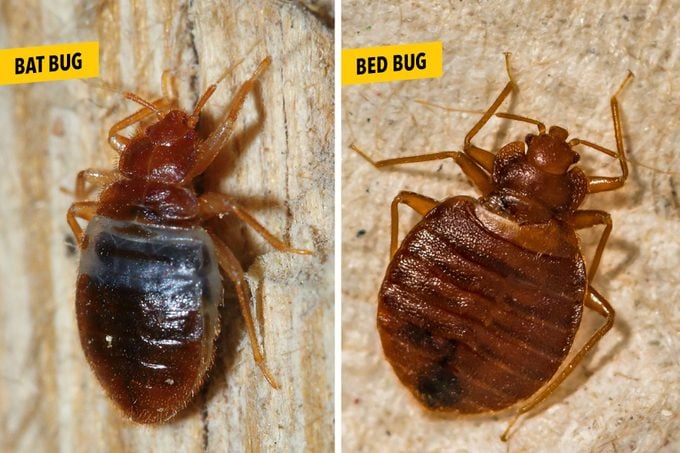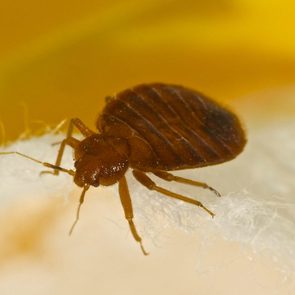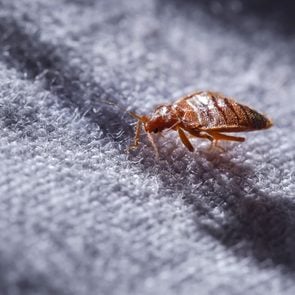Bat Bugs vs. Bed Bugs: What’s the Difference?
Updated: Sep. 18, 2023
How do you know if you have bat bugs vs. bed bugs? We explain how to tell these little "suckers" apart.

You probably know about, or have even encountered, bed bugs. But have you ever heard of bat bugs?
Bed bugs are tiny insects that suck the blood of birds and mammals. They’re one of the few species that adapted to living entirely with human beings.
Bat bugs are tiny bloodsucking insects too. But they develop and feed in colonies of live bats, hence the name.
“For much of the second half of the 20th century, bat bugs were more common than bed bugs,” says Katelyn Kesheimer, PhD, an assistant professor at the Alabama Cooperative Extension System, Auburn University, specializing in entomological research. That’s because effective insecticides eradicated much of the bed bug population.
However, in the last 20 years, the world has become more of a global society. With that has come a tremendous resurgence of bed bugs.
“Since bed bugs are so closely tied with humans, we have unknowingly transported them around and around,” Kesheimer says. “This, paired with a buildup of resistance to insecticides, has made bed bugs much more common than bat bugs at the moment.”
Bat bugs vs. bed bugs: What do they look like?
Because bed bugs and bat bugs are “cousins,” it’s not surprising they look nearly identical, at least to the untrained eye.
Both are brownish-red and similar in size, approximately a quarter-inch long. Both have short, broad heads attached to flat, oval-shaped bodies. Because both are hairy, the only surefire way to distinguish between the two is with a microscope. If you look closely, bat bugs have longer hairs around their faces than bed bugs.
Whenever you’re dealing with a potential pest in your home, Kait Chapman, an extension educator of urban entomology at the University of Nebraska-Lincoln, recommends properly identifying first. “Knowing exactly what you’re dealing with also lets you know exactly how to handle the problem,” she says. “Bed bugs and bat bugs are treated very differently.”
Bat bugs vs. bed bugs: Where do they live?
Bed bugs and bat bugs can be found on every continent except Antarctica. But bat bugs only flourish in areas with a sufficient population of bats.
Within a warm and cozy home, you’ll find bed bugs where people spend most of their time—beds, sofas, upholstered chairs and the like. Bed bugs can also infect hotels (budget and luxury) and hospitals.
Bat bugs, on the other hand, rely heavily on their hosts. They reside in attics, behind walls, in chimneys—anywhere bats might roost. Take away the hosts, and bat bugs can’t survive or reproduce for very long.
“If the bats are removed, the bat bugs will wander looking for a blood meal,” Kesheimer says. “But they will eventually die, as they cannot survive on human blood alone.”
Bat bugs vs. bed bugs: How to get rid of them
Eliminating bat bugs
To get rid of bat bugs, you have to get rid of the bats in your home. If you find a large colony of bats in your attic, contact a wildlife removal expert to help.
Once the bats have been removed, you’ll need to seal up the cracks and crevices to prevent bats from reentering the home. After that, treat the area with an insecticide specially formulated to kill bat bugs.
Eliminating bed bugs
With bed bugs, Kesheimer says the process can be challenging and potentially expensive. Depending on the extent of the infestation, it can cost hundreds or thousands of dollars.
It often takes a thorough, methodical approach with several types of treatments—heat, chemical pesticides or both. That’s why it’s crucial to take immediate action.
“Many home treatments of bed bugs, including ‘bug bombs‘ or other over-the-counter products, end up making the problem worse,” says Kesheimer. “This is because rather than killing the bed bugs, you are causing them to disperse through the residence and hide further in inaccessible places.”
She recommends hiring a pest control expert specializing in bed bugs, because only professionals stock some of the most effective insecticides against them. Before the pro arrives, you can save money by doing a lot of the prep work yourself, like washing clothes and linens, moving furniture and isolating mattresses.
“Make sure to look through all the crevices and folds of the area, especially upholstered areas like couches and mattresses, where there are bends,” Kesheimer says. “These are great harborages for the bed bugs.”
About the experts
- Katelyn A. Kesheimer, PhD, is an assistant professor and extension specialist at the Alabama Cooperative Extension System at Auburn University. She specializes in entomological research to help Alabama growers with pest problems.
- Kait Chapman is an extension educator of urban entomology at the University of Nebraska-Lincoln. She provides Nebraskans with educational and research-based information on landscape and household pests.





















